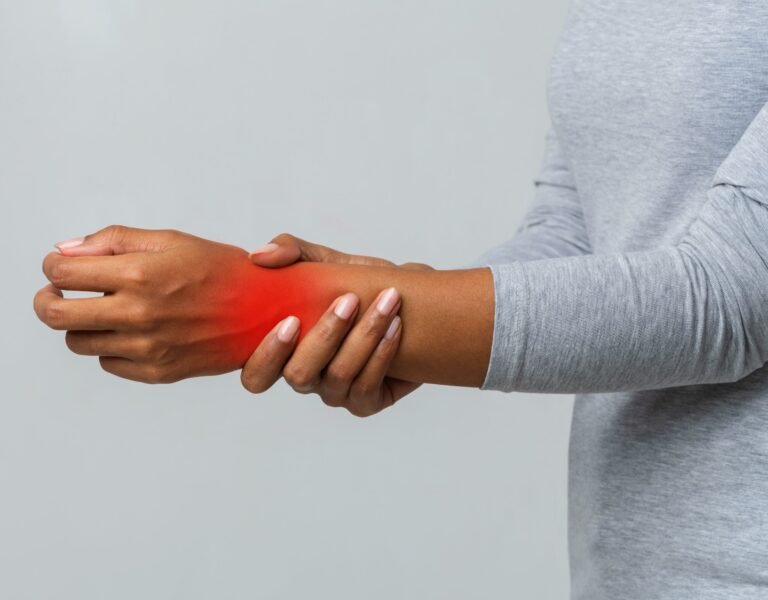You may already be familiar with some of the common aches and pains that can occur during pregnancy, including backache, SI joint pain, sciaticaand pubic symphysis dysfunction. One of the pains that may not be so obvious, however, is carpal tunnel pain. This irritation of the nerves in the wrist and hand can cause mild to severe discomfort and is actually quite common during pregnancy. In fact, some research shows that up to 62% of pregnant women experience carpal tunnel pain!
But why is carpal tunnel syndrome so common during pregnancy? In this post, we will cover what Carpal tunnel pain is, Why can occur during pregnancy (and after childbirth) and how you can manage discomfort or painful symptoms.
What is carpal tunnel pain?
Carpal tunnel pain is characterized by numbness the tingling on the hands, thumb or fingers. It could cause pain when you extend your wrist or put your hand on the ground for weight-bearing exercises such as planks or push-ups.
Why is carpal tunnel pain common during pregnancy?
Symptoms are caused by its compression median nerve inside the wrist.
During pregnancy, the following two changes can cause compression on the median nerve:
- Increased swelling: This is probably the biggest factor. During pregnancy, hormonal changes can cause an increase in fluid retention in the body, resulting in swelling (or edema). This swelling can narrow the space within the compartment that houses the median nerve.
- Poor alignment in the upper body: Physical changes during pregnancy can cause changes in your alignment. In particular, the growing belly often tilts the pelvis forward resulting in an excessive arch of the waist (or “lumbar lordosis”). A consequence of this is that the other curves in the spine will adjust, often leading to a more pronounced ‘kyphosis’ in the thoracic spine (AKA rounded shoulders and the protrusion of the head forward). This bending in the thoracic spine can also contribute to compression of the median nerve because the median nerve originates in the neck and runs in front of the shoulder and down the arm.
Carpal tunnel can also occur in the postpartum period from all the time spent in a “triple bend” position (shoulders, elbows, wrists) from carrying the baby.
How to prevent or manage symptoms
The following three strategies can help prevent or manage carpal tunnel pain.
- Get into neutral alignment: Enter your body neutral alignment it’s one of the biggest improvements you can make to alleviate nearly all common pregnancy aches and injuries — including carpal tunnel pain. Yours neck position is the most important, so try to keep a straight line between you ear-shoulder-hip — especially when sitting — as shown in the image below.

- Drink water and reduce sodium intake to minimize swelling: Water is important for so many reasons during pregnancy, and reducing swelling is another. It helps to “flush” the system and reduce fluid build-up that could cause compression.
- Keep moving: Movement during pregnancy is also important for many reasons, but especially to relieve carpal tunnel pain, improve circulation to reduce swelling.
If you experience painful symptoms—especially during exercise, the following strategies may also help:
- Perform gentle mobility tasks: At various times throughout the day, make gentle circles on the wrist in both directions. This can help take pressure off the median nerve.
- Keep the wrists and hands in a neutral position during the exercise: Usually, placing your wrists in extension (left photo below) causes the most pain. So you want to keep your wrists in a more neutral position (middle photo). If the pressure on your joints hurts, you can also try to keep your wrists neutral while in a dumbbell (right photo).

- Stick to open versus closed chain exercises: Many movements that put stress on your wrists are when your hands are on the ground, such as during planks or pushups. These exercises are called closed chain exercises, in which your hands are fixed on a surface (ie the ground). Even with modifications to the hand positions shown above, doing closed chain movements can be very uncomfortable due to the direct downward pressure on your wrists. So you might want to stick exclusively open chain movements, in which your arms are free to move in space (eg, shoulder presses, bent-over rows). There is less stress on your wrists in open chain exercises and you can better modify their position throughout the exercises.
- Keep fingers out of the way during upper body exercises: When performing open chain exercises, if the grip or fist is uncomfortable, then make sure your fingers are lengthens. One way to achieve this without giving up upper body exercises entirely is to use a cable or resistance band and hook it around your wrist instead of gripping it. If you are using a cable, follow the modification examples below to use an ankle cuff attachment and place your wrist through it instead of pushing on a cable grip.
For more persistent pain, you may want to consult a physician who can evaluate your individual case. Generally, carpal tunnel pain during pregnancy will go away once the swelling goes down (after the baby is born), but you may find it helpful to wear a brace as a reminder to keep your wrists in a neutral position (especially when you’re at the computer and when you sleep). .
Want additional resources?
For additional resources to help you exercise safely and Efficiently during pregnancy, explore us educational programs and services. You will find a variety of offers tailored to different needs — from educationto self-directed training programsin the ability to work with one special coach.
Or, if you are a health and fitness professional interested in coaching prenatal and postpartum clients, check it out ProNatal Training & Certification.
Source:
Ablove, RH, & Ablove, TS (2009). Prevalence of carpal tunnel syndrome in pregnant women. Wisconsin Medical Journal (WMJ), 108(4), 194.
